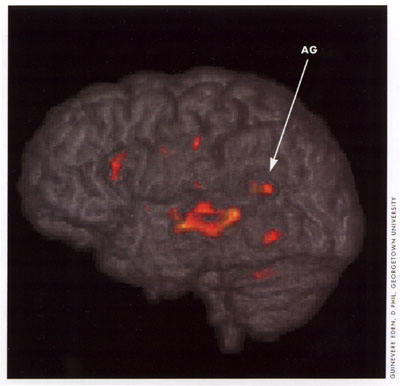
Full size
image available below |
Dyslexia and Language
Brain Areas
The
learning disability dyslexia, which centers on
difficulties in reading, once stumped scientists. Since
dyslexics often have good intelligence and even may be
gifted in some areas, it was thought that a little
motivation could get them on the right track. Now
researchers not only know that dyslexia is born of
biology, but they also are getting closer to confirming
the key brain areas that are affected. New insights will
help pinpoint therapies and improve treatment.
Albert Einstein
was a genius. And a dyslexic.
The fact that the
reading disability, dyslexia - often marked by deficits
in the decoding of words - can affect smart people, even
some famously knowledgeable, once perplexed scientists.
Many assumed that laziness was the cause.
Now research confirms
that more than a kick in the butt is needed to jumpstart
dyslexics' stall in reading. Studies show a biological
basis for this disability that affects millions of
American children and adults. One line of research
indicates that dyslexics use the brain regions that
process written language differently than those without
the disorder.
New advances are leading to:
- Earlier diagnosis and treatment of dyslexia.
- Fine-tuning of therapies.
- A better understanding of the nature of dyslexia.
For decades
after researchers first described dyslexia, many people
contended that it stemmed from a "slacker" attitude.
Then, almost a century later, scientists began to
unearth hints that the disorder was backed by biology.
In 1979 a report indicated that anatomical abnormalities
existed in a dyslexic patient. The left side of the
brain of the 20-year-old who died accidentally depicted
disorganization in the cells that control language
areas.
The finding
caused researchers to investigate the brain's
involvement in dyslexia.
Many scientists have
identified brain regions related to dyslexia with
high-tech imaging techniques that photograph the brain
in action. The tools have helped them link the
disability to speech sound processing, vision and
language brain systems. Today researchers are
systematically scrutinizing large numbers of dyslexics
to determine which areas of the brain are the most
involved and to understand how they relate to each other
and contribute to different degrees and varieties of the
disability. Dyslexia's symptoms, which may include
deficits in spelling, in recognizing sounds in words, in
processing rapid visual information and in saying words
quickly when put on the spot, have made it difficult for
researchers to tease apart the key brain regions
involved.
While the
areas most central to the disability are still
uncertain, many researchers suspect that the brain areas
that control language play a critical role. One of these
areas that keeps coming up in studies is the angular
gyrus (AG). Located toward the back of the brain, the AG
translates the mass of words and letters we encounter in
day-to-day life into language.
Some researchers
believe the area, which is known to be involved in
normal reading, is a key component of an overall
"reading pathway" in the brain. Recent studies of a
variety of reading and language tasks in dyslexic
individuals showed less activity in the AG than those
without the disability. The researchers suspect that
this part of the brain does not function normally in
dyslexics.
Some
scientists speculate that dyslexics use the area
inadequately and may compensate by using other brain
areas, such as the inferior frontal gyrus, which is
located in the front of the brain, and is associated
with spoken language. For example, dyslexics who say the
words they are reading under their breath may rely
heavily on this area to get through a passage of text,
according to one theory.
Many researchers also
are using imaging techniques to see if the behavioral
interventions sometimes used to treat those with
dyslexia actually modify brain activity. One group is
reviewing three separate interventions thought to target
either the brain system that processes written language,
the speech sound processing system or the visual system.
The results could
help confirm the brain areas that are common to the many
forms of the disability and lead to a fine-tuning of
interventions.

Several
imaging studies of reading and language skills
show that the AG is involved in dyslexia. One
group of researchers currently is studying how
dyslexics perform pig latin tasks compared to
normal readers. Pig latin requires dissecting and
reordering the sounds within a word. For example,
if a word begins with a consonant, the first
letter is moved to the end of the word and "ay" is
added. "Pig" becomes "igpay." It is a difficult
test for dyslexics because it challenges their
ability to sound out written words as well as
their memory skills. The image above shows that
activity in the AG is increased in a normal reader
who performs the pig latin task. The researchers
suspect that the activity will be lower in
dyslexic readers.
|
|
Image by Guinevere Eden, D.Phil, Georgetown
University |
For more information please contact Leah Ariniello,
Science Writer, Society for Neuroscience, 11 Dupont
Circle, NW, Suite 500, Washington DC 20036. |
